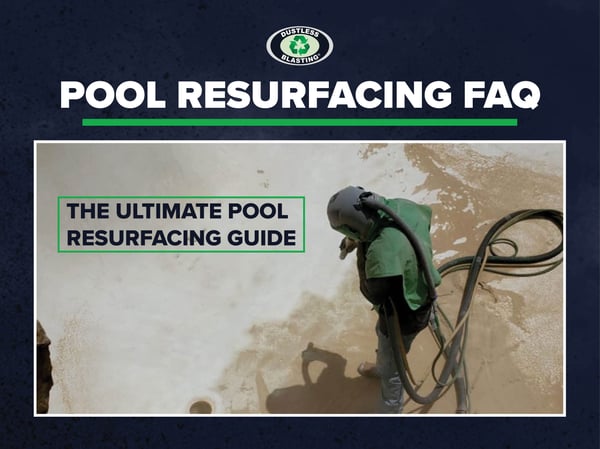Pool Resurfacing: The Complete Guide
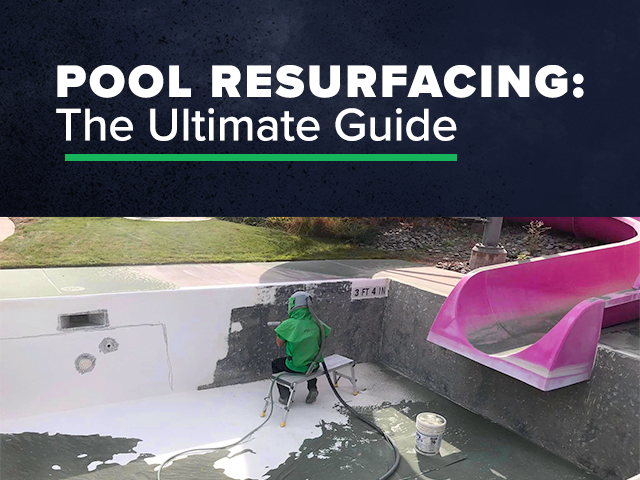
Pool resurfacing is a process that involves renewing the surface of a swimming pool. Over time, swimming pools can deteriorate due to exposure to the elements, harsh chemicals, and everyday wear and tear. This can lead to a range of issues such as leaks, cracks, discoloration, and roughness. Resurfacing a pool, regardless of the pool type, is a great way to give it a new lease of life and improve its appearance, safety, and longevity. In this guide, we will explore the different types of swimming pools, various pool resurfacing methods and equipment, and other factors to consider regarding maintenance and cleaning.
Benefits of Pool Resurfacing
There are several benefits of swimming pool resurfacing, including:
-
Improved Appearance: Resurfacing a pool can give it a new, fresh look. You can choose from a range of colors, patterns, and textures to customize the look of your pool.
-
Increased Safety: Resurfacing a pool can improve its safety by repairing cracks and leaks, and creating a smooth, slip-resistant surface.
-
Enhanced Functionality: Resurfacing a pool can improve its functionality by improving its water flow, reducing water loss, and improving its energy efficiency.
-
Increased Longevity: Resurfacing a pool can increase its longevity by protecting it from further damage and preventing the need for costly repairs down the line.
Types of Swimming Pools
In order to know which method and equipment is best for your resurfacing project, you need to know the different swimming pool types and how to properly resurface each one depending on the surface. Let's take a look at each type of swimming pool.
Concrete or Gunite Pools
A concrete pool, also known as a gunite or shotcrete pool, is a type of swimming pool that is built by spraying a mixture of concrete and sand onto a steel frame or rebar structure. The concrete is then shaped and smoothed by hand to create the desired pool shape. Concrete pools allow for custom designs and can be built to fit any size or shape. They can also include various features such as waterfalls, slides, and steps. Once the concrete has cured, the pool is then finished with a layer of pool plaster, Pebble Tec, tiles, or other finishes to create a smooth, water-tight surface.
Fiberglass Pools
A fiberglass pool is a type of swimming pool that is made from a single-piece fiberglass shell. The pool is manufactured in a factory and then transported to the site where it will be installed. Fiberglass pools have a smooth, non-porous surface that resists algae growth, and are available in a variety of shapes and sizes. The installation process for a fiberglass pool is typically faster than other types of pools, as the pool shell is simply placed into a pre-dug hole and then leveled and secured. Fiberglass pools are also known for their durability and longevity, as the fiberglass material is resistant to cracking and fading. Additionally, fiberglass pools require less maintenance than other types of pools, as the smooth surface is easier to clean and requires fewer chemicals to maintain proper water chemistry.
There is also an option for adding a fiberglass gel coating over pool plaster.
Vinyl Pools
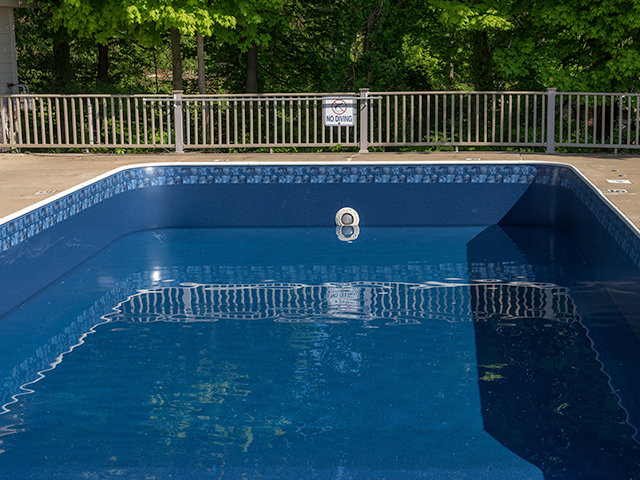
A vinyl pool is a type of swimming pool that is constructed with a flexible vinyl liner that is placed over a frame or wall structure made of steel, aluminum, or wood. Vinyl pools are available in a wide range of shapes and sizes and can be customized to fit the specific needs of the homeowner. They are also relatively easy to install, typically taking less time than other types of pools, and are a budget friendly option compared to concrete or fiberglass pools.
Signs A Pool Needs Resurfacing
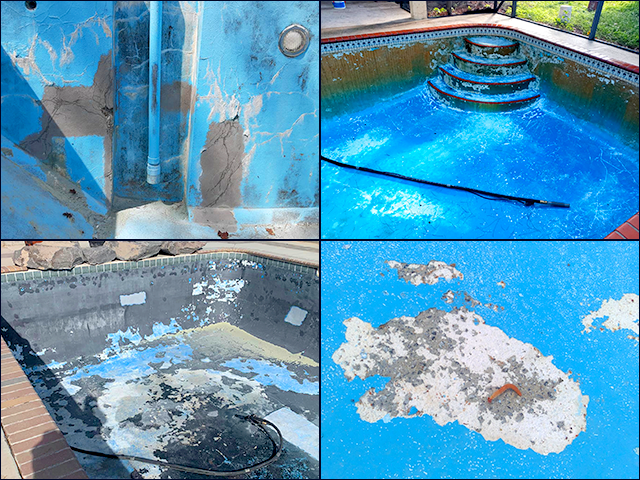
Every pool is different and will show various signs that it needs a new surface. Here is a short list to see if it's time to begin a swimming pool resurfacing project:
-
Structural cracks
-
Color Distortion
-
Blister Contamination
-
Flaking plaster
-
Surface Stains
-
Rust Stains
-
Rough Surface
How To Resurface A Pool
There are many different pool resurfacing options depending on the surface. We'll go over how to resurface various pool types below. For additional information on pool resurfacing options, view this blog.
Resurfacing Concrete Pools: Plaster Removal
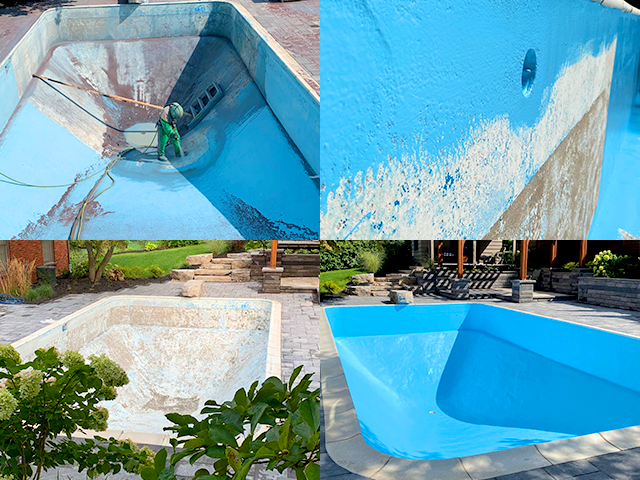
This is the most common type of pool resurfacing. Plaster is a mixture of cement, sand, and water, and is typically applied in a thickness of ¼ to ½ inch. Plaster is durable and provides a smooth, clean finish. However, plaster can be prone to cracking and staining, and may need to be resurfaced every 7 to 10 years.
Removing old plaster from a concrete pool is a necessary step before resurfacing. Traditional methods of removing plaster is through the use of grinders or a sandblaster. However, these methods can be messy, time-consuming, and create a lot of dust, which can be harmful to breathe in. A newer method of removing plaster from a pool is through the use of Dustless Blasting equipment.
Dustless blasting involves the use of water and abrasive media to remove the old plaster without creating any dust. The water helps to suppress the dust, making the process cleaner and safer. This method is faster and more efficient than traditional sandblasting because you'll get a lot more velocity and impact out of your media with it submerged in water than you would with dry air. Dustless blasting is also environmentally friendly, as the operator can use chemically inert media, like recycled glass, which is safe for the environment. Overall, Dustless Blasting is a great option for those looking to remove plaster from concrete pools in a safe, efficient, and eco-friendly manner. Learn more about plaster removal with Dustless Blasting in this article.
For example, this entire 1800 square foot apartment complex pool was stripped down in ten hours time with one operator. This contractor was hired by a pool resurfacing professional company because they were going through several hand grinders a day. See more pool resurfacing case studies with Dustless Blasting, here.

Once the failing or loose plaster is eliminated, you'll need to treat the surface with a layer of bond coat. This helps to ensure the new plaster adheres properly to the pool. The final step is to apply the new plaster using a trowel or plastering tool.
Fiberglass Pool Resurfacing
Resurfacing a fiberglass pool involves removing the old gelcoat and opening up blisters before adding a new layer of gelcoat can be applied to restore its appearance. Blisters are known scientifically as osmosis and are the unfortunate sign that a pool surface has reached its expiration date. Once the pool is drained, the surface needs to be sanded or blasted to remove any old gelcoat and open up the blisters. Unfortunately, this is a very timely process if one chooses to use hand sanders or grinders. We recommend opening up blisters with Dustless Blasting equipment to increase production rates by 80%.
Once the surface is prepped, a new gelcoat will need to be applied using a spray gun or roller. Gelcoat is a type of resin that is designed to bond with the fiberglass and provide a smooth, durable finish.
Resurfacing Vinyl Pools
Many homeowners choose to experience the convenience of vinyl liners due to its low-maintenance. With no resurfacing required, these durable plastic bags provide lasting protection but need to be replaced every 5-9 years for optimal performance.
Tile Resurfacing
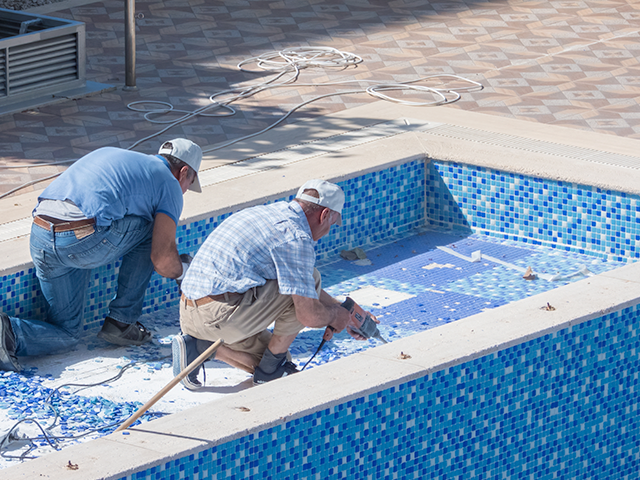
Tile resurfacing involves replacing the existing pool surface with tiles. Tiles are durable and come in a range of colors and patterns, which makes them a popular choice for most homeowners who want a customized look. Tile resurfacing is also easy to maintain and can last up to 25 years. However, tile resurfacing is more expensive than plaster or Pebble Tec resurfacing, and can be prone to cracking and chipping.
Pool Deck Resurfacing
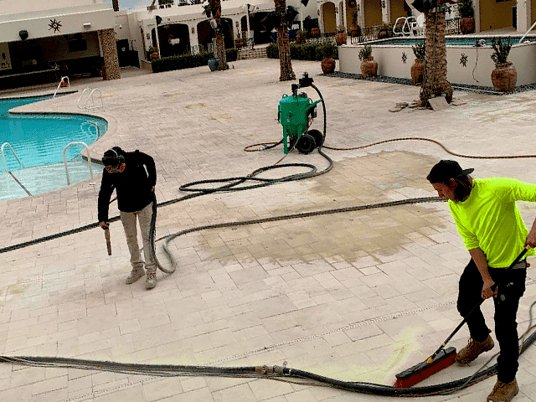
Every pool oasis needs a safe but beautiful pool area. Over time, pool deck surfaces may become damaged, stained, or worn out due to constant exposure to water, sunlight, and harsh weather conditions. Resurfacing is an effective way to restore the look and functionality of a pool deck. In this blog, we'll discuss different types of pool decks and the best way to resurface them.
Resurfacing Options
Here are the most common and most recommended resurfacing methods we've seen used by pool resurfacing professionals.
Abrasive Blasting - Dustless Blasting
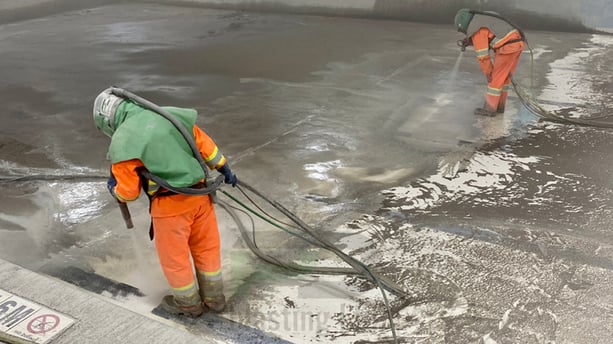
As previously mentioned, Dustless Blasting can be used to restore various pool surfaces -whether you're removing plaster from an entire pool, opening blisters on fiberglass pools or cleaning calcium deposits from glass tile. This abrasive blasting system uses water mixed with media and adjustable pressure technology to remove tough coatings or clean delicate substrates like ceramic tiles. The secret to success is choosing the right media and adjusting your pressure settings depending on the project.
Most pool professionals prefer this method because they can blast in residential spaces without creating a hazardous dust plume that will effect others nearby. In the photo above, contractors are blasting an indoor pool without creating a plume of dust.
Sandblasting
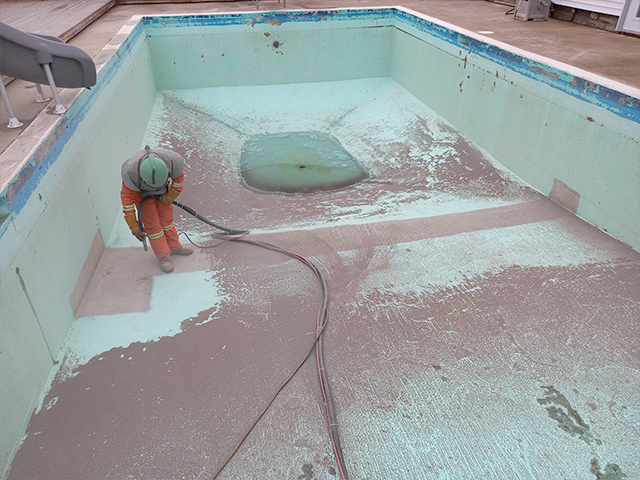 Traditional sandblasting is a commonly known method for removing plaster and pool paint. While this technology can be successful in removing coatings from a pool surface, it does come with health and environmental risks.
Traditional sandblasting is a commonly known method for removing plaster and pool paint. While this technology can be successful in removing coatings from a pool surface, it does come with health and environmental risks.
Unlike Dustless Blasting, sandblasting will create a large cloud of dust when in use. This requires the use of respirator system that supplies clean air. It is also important not to blast with others nearby.
Hand Tools
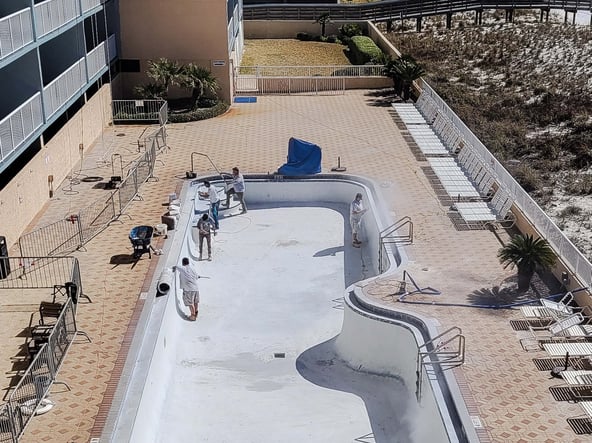
While hand tools are a cost effective option, they are also the most time consuming option. Using a grinder to remove plaster or open up a large amount of blisters can take weeks. You will also go through several grinders depending on the pool size. Even though the grinders themselves are cheaper than a blasting system, your labor costs will increase due to this method being the most labor intensive process.
How Much Does Pool Resurfacing Cost?
The pool resurfacing cost depends on the pool's size and and the pool surface. On average, most pool owners can expect to spend $6,500 for a pool measuring 1,000 square feet. Let's break this down by the pool finish, materials and types.
Glass tiles are a beautiful option but they're also the most expensive. Completely tiling a pool will be the most costly option. Depending on the tile, it costs anywhere from $4 to $30 per square foot. To save on material costs, we recommend applying waterline tile and using a more affordable finish below.
Plaster is a great option that many pool professionals recommend because it's durable and cost-effective. If applied correctly, it will last around 10 years and pool replastering costs around $5 per square foot.
Aggregate finishes are another option that could include pebbles, glass beads or crushed stone and typically costs $5-$7 per square foot.
Pool paint is the cheapest option but also the least durable. Pool paint costs around $1-$2 per square foot but only has a lifespan of 2-5 years.
Vinyl pools don't require refinishing as the entire liner needs to be replaced every 5-9 years. This can cost anywhere between $1-$3.5 per square foot.
Pool Cleaning
Pool Tile Cleaning
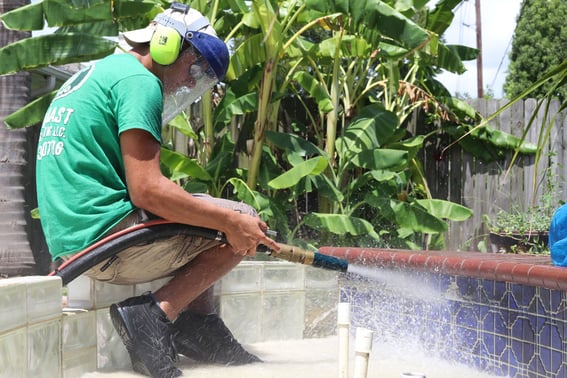
Not all projects require total resurfacing. Some pool owners just need light or aggressive cleaning. It is important to note that different types of pool tiles may require different cleaning methods. Some tiles may be more delicate and require gentler cleaning methods, while others may be more durable and able to withstand more aggressive cleaning. Below are a few options for cleaning pool tiles:
-
Dustless Blasting with a soft media (like glass beads) to leave a smooth texture.
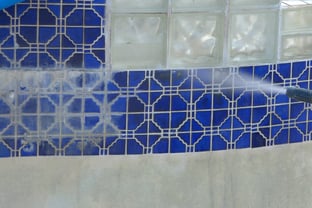
-
Pressure Washing
-
Scrubbing with a tile brush
-
Chemical Cleaning
-
Steam Cleaning
For more information on pool tile cleaning and the best calcium removal method, checkout this related article.
Acid Wash
Pool acid wash is a process of removing stubborn stains and discoloration from the surface of a swimming pool by using a mixture of water and muriatic acid. This process is usually done when regular pool cleaning methods like scrubbing, brushing, and chemical treatments have failed to remove the stains. While pool acid wash can be an effective solution for restoring the appearance of a pool, it should be performed by a professional due to the potential hazards associated with handling acid.
Pool Resurfacing: DIY vs. Hiring a Professional
Swimming pool resurfacing can be a challenging task, and deciding between DIY and hiring a professional depends on various factors. DIY restoration can be a cost-effective option, but it requires a certain level of expertise and experience to ensure a successful outcome. One needs to have the right tools, materials, and knowledge of the correct procedures to resurface a pool effectively. On the other hand, hiring a professional pool restoration company can offer several benefits, such as quality work, efficient use of time and resources, and access to specialized equipment and products. A professional team can also assess the extent of the damage and recommend the best approach for restoration. Additionally, they can identify any underlying issues that may cause problems in the future and provide advice on how to maintain the pool's condition. Ultimately, the decision to undertake a DIY or hire a professional for swimming pool resurfacing should be based on the pool's condition, the extent of damage, and the skills and experience of the person doing the restoration.
Frequently Asked Pool Resurfacing Questions
We know that resurfacing a pool stirs up lots of important questions. If you'd like to know more about pool restoration with Dustless Blasting, checkout this applications page. For more FAQs regarding pool resurfacing, read this article.
Start Resurfacing Pools With Dustless Blasting
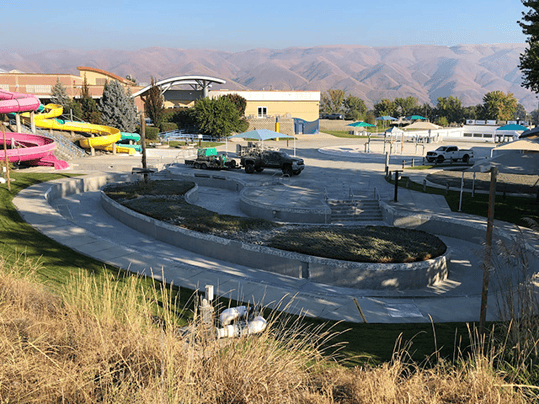
Easily resurface a whole pool with Dustless Blasting equipment in record time. Whether you need a standalone blast pot or a complete portable system that can be transported from job to job - this equipment is perfect for pool resurfacing. Call one of our blasting experts or get a quote today!
